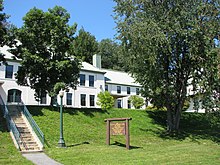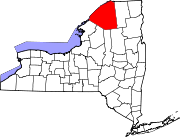
Franklin County is a county on the northern border of the U.S. state of New York. To the north across the Canada–United States border are the Canadian provinces of Quebec and Ontario, from east to west. As of the 2020 census, the county population was 47,555. Its county seat is Malone. The county is named in honor of United States Founding Father Benjamin Franklin.

St. Lawrence County is a county in the U.S. state of New York. As of the 2020 census, the population was 108,505. The county seat is Canton. The county is named for the Saint Lawrence River, which in turn was named for the Christian saint Lawrence of Rome, on whose feast day the river was visited by French explorer Jacques Cartier.

Clifton is a town in St. Lawrence County, New York, United States. The population was 675 at the 2020 census. The town takes its name from a mining company.

Colton is a town in St. Lawrence County, New York, United States. The population was 1,451 at the 2010 census. The town, originally named "Matildaville", is named after early settler Jesse Colton Higley.

Fine is a town in St. Lawrence County, New York, United States. The population was 1,512 at the 2010 census. The town is named after Judge John Fine, a businessman involved in settling the town.
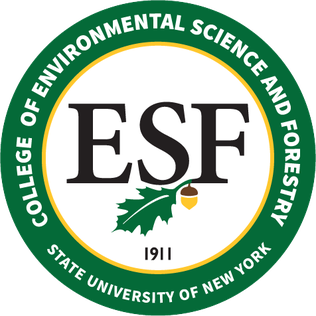
The State University of New York College of Environmental Science and Forestry (ESF) is a public research university in Syracuse, New York focused on the environment and natural resources. It is part of the State University of New York (SUNY) system. ESF is immediately adjacent to Syracuse University, within which it was founded, and with which it maintains a special relationship. It is classified among "R2: Doctoral Universities – High research activity".

The Adirondack Park is a multi-use park in northeastern New York protecting the Adirondack Mountains. The park was established in 1892 for "the free use of all the people for their health and pleasure", and for watershed protection. At 6.1 million acres, it is the largest park in the contiguous United States.

The Oswegatchie River is a 137-mile-long (220 km) river in northern New York that flows from the Adirondack Mountains north to the Saint Lawrence River. The Oswegatchie River begins at Partlow Lake in Hamilton County, New York. The river continues through Cranberry Lake which was 'doubled in size' through construction of a dam in the late 1860s. The river continues from the dam to Gouverneur, to near Talcville in St. Lawrence County, where it joins the West Branch. Much of it is within Adirondack State Park. The city of Ogdensburg developed at the mouth of the river at its confluence with the St. Lawrence.

Cranberry Lake is a lake on the east branch of the Oswegatchie River in the Adirondack Park in New York in the United States. It is the third largest lake in the Adirondack Park. About 75 percent of the shoreline is owned by the State of New York. The 118,000-acre (480 km2) Five Ponds Wilderness Area abuts its south shore, and the Cranberry Lake Wild Forest covers much of its remaining shoreline.

Robert Marshall was an American forester, writer and wilderness activist who is best remembered as the person who spearheaded the 1935 founding of the Wilderness Society in the United States. Marshall developed a love for the outdoors as a young child. He was an avid hiker and climber who visited the Adirondack Mountains frequently during his youth, ultimately becoming one of the first Adirondack Forty-Sixers. He also traveled to the Brooks Range of the far northern Alaskan wilderness. He wrote numerous articles and books about his travels, including the bestselling 1933 book Arctic Village.
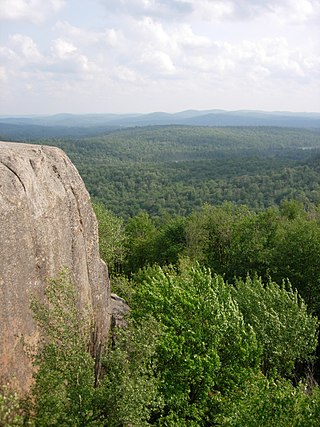
The Five Ponds Wilderness Area, an Adirondack Park unit of New York's Forest Preserve, is located in the towns of Fine and Clifton in St. Lawrence County, the town of Webb in Herkimer County and the town of Long Lake in Hamilton County. It includes 1,064 acres (4.3 km2) of private inholdings, 99 bodies of water covering 1,964 acres (7.9 km2), 57.9 miles (93.2 km) of trails, and 14 lean-tos.
Big Deer Pond in Hamilton County, New York is located approximately 1.5 west of Lows Lake in the Five Ponds Wilderness Area and the Adirondacks "Bob Marshall Wilderness" area. It serves as a 1/2 mile water-portage between Lows Lake and the upper Oswegatchie River. The portage is a total of 3.5 miles through blowdown of virgin timber. Big Deer Pond is noted for being a large shallow pond with numerous bog plant life. It was initially named Lost Pond by surveyor Verplanck Colvin before being rediscovered by conservationist Bob Marshall after the turn of the 20th century.

High Falls is a small but picturesque waterfall on the upper Oswegatchie River in the Five Ponds Wilderness. It is located in the town of Fine, in a remote part of Adirondack State Park in St. Lawrence County. The falls drops about 20 feet (6.1 m). Access is by canoe or by maintained hiking trails. The closest public road, near Wanakena, is almost six miles to the north. Trail access is by a short spur from the High Falls Loop Trail. The most direct canoe access is by way of the Oswegatchie River from the Oswegatchie River Inlet on Inlet Road. The waterfall has been designated a scenic special interest area in the New York State Land Master Plan.

Cranberry Lake is a hamlet in the eastern part of the Town of Clifton, in St. Lawrence County, New York, United States. It lies along New York State Route 3 on the north shore of Cranberry Lake. The population was 200 at the 2010 census, which lists the community as a census-designated place.
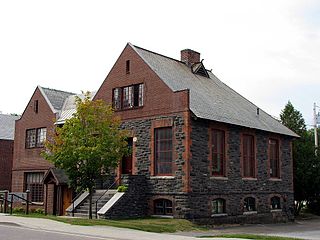
Historic Saranac Lake is a non-profit, membership organization dedicated to the preservation of the history and architectural heritage of the Saranac Lake area of New York State in the Adirondacks.
The New York State College of Forestry at Cornell was a statutory college established in 1898 at Cornell University to teach scientific forestry. The first four-year college of forestry in the country, it was defunded by the State of New York in 1903, over controversies involving the college's forestry practices in the Adirondacks. Forestry studies continued at Cornell even after the college's closing.
The New York State College of Forestry, the first professional school of forestry in North America, opened its doors at Cornell University, in Ithaca, New York, in the autumn of 1898., It was advocated for by Governor Frank S. Black, but after just a few years of operation, it was defunded in 1903, by Governor Benjamin B. Odell in response to public outcry over the College's controversial forestry practices in the Adirondacks.

The Wanakena Footbridge was a pedestrian suspension bridge located at Wanakena in St. Lawrence County, New York. It was constructed in 1902 and spanned the Oswegatchie River. It was originally constructed to provide a crossing for the employees of the Rich Lumber Company to reach the no longer extant mills.

The SUNY-ESF Ranger School, on the east branch of the Oswegatchie River near Wanakena, New York, offers A.A.S. degrees in forest and natural resources management. Established in 1912, the school is affiliated with the State University of New York College of Environmental Science and Forestry (SUNY-ESF). The Ranger School commemorated its centennial in 2012-13.



